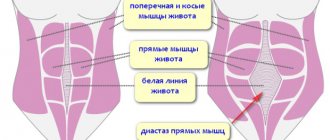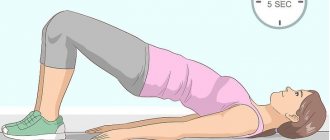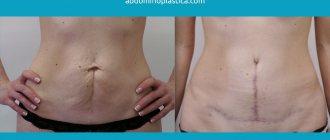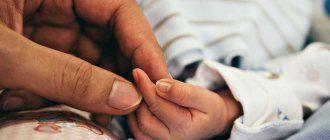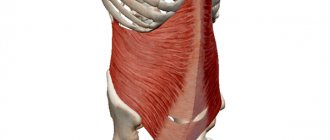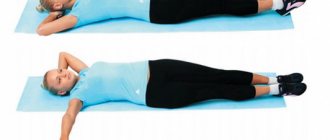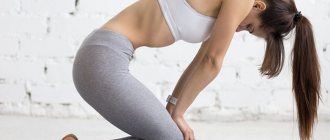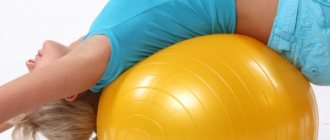Pregnancy and childbirth are a serious test for the body, including the female figure. Often after giving birth, a woman sadly observes a sagging belly in the mirror. The muscles and skin are greatly stretched during childbirth, and now there is a bag in place of the flat tummy. But any mother is, first of all, a woman who wants to be beautiful and desirable.
What should a young mother do if she doesn’t have time for hours of training in the gym, and breastfeeding doesn’t allow her to go on a strict diet?
Fortunately, there is no need to be torn between the desire to have a beautiful figure and caring for a child. We offer a procedure that will help you quickly get your stomach in order and prepare for the beach season. This is myostimulation - a figure correction technique based on the effect of current pulses on muscles.
| PROCEDURES |
| Myostimulation |
Myostimulation: mechanism of action on the body
During the procedure, electrodes are applied to problem areas through which current is supplied. Under its influence, the muscles contract, just like when doing fitness. Muscles become toned, their strength and volume increase.
In addition, myostimulation helps fight local fat deposits, which is also important for young mothers who have gained extra pounds during the months of pregnancy. Another positive effect of myostimulation is skin tightening, which in women who have given birth often becomes flabby and loses its elasticity.
The result of the myostimulation course is a toned stomach, smooth, elastic skin. Naturally, the result will be achieved if you make some efforts yourself: try to eat right and move as much as possible.
Myostimulation: the essence of the procedure, the mechanism of action
A special gel is applied to the skin in the problem area, and electrodes are placed on top through which electrical impulses are applied. The gel serves as a conductor, facilitating the passage of impulses through the skin. The impulses act on the muscles, causing them to contract.
Myostimulation: before and after
Rhythmic contraction of muscles under the influence of electrical impulses improves their tone and ensures muscle growth. The effect is the same as with regular exercise in the gym: toned buttocks and legs.
An additional effect of myostimulation is improvement of blood circulation, lymph flow, removal of decay products from the body, elimination of congestion. That is why the procedure is effective against cellulite and local fat deposits.
That is, after a course of myostimulation, you get rid of the “orange peel”, tighten your muscles, and lose weight.
Rules for exercising after childbirth
Low-intensity training is beneficial for new mothers, but with certain limitations.
Don't rush to start . Doctors recommend introducing fitness classes no earlier than six months after giving birth. “Any sports activities can be started no earlier than 6-8 months after birth. Much will depend on what the birth was like - natural without pathologies, with complications or cesarean section, says Anastasia Sergeeva. - In any case, the loads should be light even after so much time. The most preferred are fitness classes, yoga, stretching, and active walking.”
However, much depends on the woman’s initial health and the lifestyle she led before pregnancy and childbirth. If active fitness has always been present in your schedule and you feel good, then some exercises can be introduced earlier. “If there are no contraindications from your doctor, you can strengthen your abdominal muscles 1.5-2 months after giving birth,” explains Denis Savchenko , personal trainer of the ArtFitness club chain.
Discuss the situation with your doctor. When it comes to recovery after childbirth, there are no universal solutions; much depends on the woman’s health status. Therefore, before starting training, it is advisable to see a doctor. “ We need an integrated approach both in physical activity on different muscle groups and in consultation with specialists. It would not be superfluous to consult an obstetrician-gynecologist or surgeon. You need to plan physical activity under the supervision of a rehabilitation medicine doctor or rehabilitation trainer,” adds Anastasia Sergeeva.
Do exercises for the lumbar region. “Often, young mothers have overloaded lower back. First you need to very carefully remove the hypertonicity of the lower back, then gradually pump up the back muscles. Imagine, 9 months of carrying a child in your stomach, then carrying him in your arms - all this “hits” the lower back, so she also needs attention,” says Denis Savchenko.
Simple movements on a fitball, myofascial release techniques, and the “cat” exercise are suitable.
Avoid intense workouts and heavy lifting. This is especially dangerous with diastasis.
Gradually strengthen your abdominal muscles. But again, not with the help of classic crunches. “It is necessary to exclude twisting, dynamic abdominal work, static work, and only when exhaling, drawing in the abdomen. Avoid heavy lifting,” advises Denis Savchenko.
What exercises are allowed? “With diastasis and in the initial stages of training, we limit ourselves only to static exercises (planks) and abdominal vacuum,” says Denis Savchenko. “In planks, only the rectus abdominis muscle is worked, while vacuum variations involve the transverse muscle.”
Increase the load gradually. Even if you trained five times a week before pregnancy, you need to return to the regime after childbirth very smoothly. “The main law here is the smooth transition from simple to complex. And after some time, you will start doing classic crunches and, in general, you will be able to return to your previous training,” adds Denis Savchenko.
Exercises after childbirth
Olga Petrovich
September 21, 2016
Some women worry during pregnancy about what their body will be like after childbirth. And it’s not even about extra pounds, but about the general condition of the body. Often, women who have given birth are left with stretch marks on their abdomen, varicose veins and incontinence, so it is necessary to tone yourself up, even if the scales show the same numbers as before giving birth. If the birth was easy and you did not have to be stitched up, then you can start doing exercises literally the next day after the baby is born. But in the case of surgical intervention, it is necessary to wait until the sutures have completely healed, which occurs after about two months.
The most problematic part of the body after childbirth is, of course, the stomach. Weakened and stretched muscles, as well as a lack of urge to urinate, cannot but upset young mothers. In order to gradually restore your stomach, five minutes of exercise a day is enough. And here are some simple exercises. 1. Abdominal retraction. To perform this exercise, you need to lie on your back and bend your knees, pressing your feet firmly to the floor, while placing your palms on your stomach. While exhaling, you need to pull in your stomach as much as possible and remain in this position for 4-5 seconds, after which we take a deep breath and repeat the exercise again (about ten times). 2. We stand on the “bridge”. We take the same pose as described above, but after exhaling, we raise the pelvis and draw in the stomach, while straining the buttocks. You need to raise your head and press your chin to your chest. It is possible that you will not be able to fully perform this exercise right away, but do not despair, over time your muscles will become stronger and the number of repetitions will increase. 3. Breathe correctly. We take the same starting position as in the first exercise and begin to breathe. Slowly inhale and exhale calmly, while exhaling as if you were pronouncing a long sound “ha”. You should not put pressure on the stomach with your hands; you can help with your hands by gently stroking the stomach from the pubis to the navel. This exercise also needs to be repeated about ten times. The same can be repeated while lying on your side. 4. On the stomach. We turn over with our backs up, for convenience we place a small pillow under the lower abdomen, and lean on our elbows. We inhale the air deeply, and as we exhale we move forward with our pelvis and when we inhale we return to the starting position. It is important to understand here that the breast should be empty after feeding, but in any case there is no need to put pressure on it. It costs about 10-12 times to perform this exercise. After childbirth, it is necessary to tighten not only the abdominal muscles, but also the entire body in principle. But it is worth considering that some exercises can be done only after feeding, and all movements must be performed smoothly and carefully. To prevent the occurrence of varicose veins, you need to regularly perform leg exercises. The starting position for the two most common and effective exercises is the same - lying on your back, stretch your arms along your body and place your palms down. We bend our legs at the knees, bring our feet together and press them to the floor. And then there are several options: 1. Without separating your feet, straighten your legs and strongly squeeze your toes. Perform this action about 10 times and return your legs to their previous position. 2. Raise one leg up and completely straighten it at the knee, then with a large amplitude, pull the toe away from you and towards you about 10 times. For the back, in combination with the stomach, one simple exercise is suitable: stand facing the wall and rest your forearms and palms against the wall, spread your legs shoulder-width apart and slightly bend your knees. Now we begin to contract the press as if we were reaching the opposite knee with our elbow. It turns out that the movement itself is not performed, but the necessary muscles contract. And, of course, any mother who has recently given birth needs to do exercises that help strengthen the muscles of the perineum. An exercise that is very similar to the famous Kegel exercises is perfect here. While sitting or lying down, you need to concentrate and try to contract the muscles of the vagina first, and then the anus. Most likely, you won’t be able to do this right away. This exercise requires training, and after you can perform it correctly and clearly, learn to do the so-called “wave,” that is, contract the muscles alternately from the pubis to the anus and back. By the way, performing the last exercise is useful not only after, but also before childbirth, as, in general, are many strengthening exercises. After all, a healthy and prepared body will endure childbirth much easier and get into shape faster after it.
Olga Petrovich
Tags:
- Exercises
- Childbirth
A set of exercises for the abdominal muscles after childbirth
We suggest taking the following set of exercises developed by Denis Savchenko as a basis for working with the abdominal muscles.
How to build a lesson
- Start the lesson with a light joint warm-up - do a few bends, rotations with your arms and legs.
- Perform the exercises sequentially at a slow pace.
- Rely on your condition: trainers recommend performing exercises for 5-10 repetitions, but if this is still difficult for you, do fewer movements. Gradually, the body adapts, the muscles will become toned and you will be able to increase the number of repetitions.
- Do this program twice a week. Over time, the amount of training can be increased.
Abdominal vacuum
Get down on your knees, lean your body forward, placing your palms under your shoulders. Inhale, then exhale deeply and slightly pull your stomach under your ribs. Then relax your stomach and inhale. This is one repetition, do 5-6 of these (or more if you can do it).
Static twisting of the body
Lie on the floor, bend your knees and place your feet on the mat. Place your hands behind your head. As you exhale, twist your body slightly forward and upward, lifting your shoulder blades off the floor. Hold this position for 5-10 seconds. Repeat several times if desired.
Static twisting of the body with leg lifts
Lie on the floor, bend your knees and place your feet on the mat. Place your hands behind your head. Raise your legs up, bending your hips, shins parallel to the floor. At the same time, as you exhale, twist your body slightly forward and upward, lifting your shoulder blades off the floor. Hold this position for 5-10 seconds. Repeat several times if desired.
Vacuum lying on your back
Lie on your back, press your sacrum to the floor, keep your lower back in a neutral position. Inhale, then exhale deeply and slightly pull your stomach under your ribs. Then relax your stomach and inhale. This is one repetition, do 5-6 of these (or more if you can do it).
Side plank (simplified version)
Lie on your right side. Bend your right elbow and rest on your right forearm. Bend your knees. Lift your pelvis off the floor into a side plank position from your knees. Place your left hand on your belt. Actively work your abdominal muscles. Stay in this position for 10-15 seconds (or more). Do the same thing in the other direction. Repeat several times if desired.
Side plank (full version)
Lie on your right side. Bend your right elbow and rest on your right forearm. Stretch your legs. Lean on the sides of your feet. Place your left hand on your belt. Lift your pelvis off the floor and extend your body into one straight line. Actively work your abdominal muscles. Stay in this position for 10-15 seconds (or more). Then do the same in the other direction. Repeat several times if desired.
Leg raise while lying on your side
Lie on your right side. Place your right hand behind your head and place your left hand on your belt. Stretch your legs. Using your abdominal muscles, smoothly lift your legs above the floor. Hold at the top for 2 seconds, then lower your legs down (without your feet touching the floor). This is one repetition, do 7-10 of these. Then do the same in the other direction.
Plank (simplified version)
Drop to your knees, then walk your hands forward and place your forearms on the floor. Raise your feet up, rest on your forearms and knees. Work your abdominal muscles. Secure yourself in the plank, do not bend your lower back. Stay in this position for 8-10 seconds (or more). Repeat if desired.
Physical and hormonal restoration of the vagina after childbirth
Due to hormonal changes caused by pregnancy and childbirth, many women complain of discomfort and dryness in the vagina after childbirth, and some women also begin to suffer from hemorrhoids after childbirth. If you encounter this problem, be sure to tell your doctor about it. He will conduct an examination, take a smear from the vagina for examination and, based on the information received, prescribe appropriate treatment.
Changes in hormonal levels in the postpartum period are a completely natural reaction of a woman’s body to her new condition.
In most cases, it returns to normal on its own. If the gynecologist does not find serious violations, you can limit yourself to moisturizing the vaginal walls with special means - for example, Ginocomfort moisturizing gel.
However, sometimes itching and discomfort after the birth of a baby may indicate another problem - a violation of the ratio of beneficial, pathogenic and opportunistic microorganisms inhabiting the vagina. The cause of dysbiosis (Dysbacteriosis) in the postpartum period can be a general decrease in the body's defenses caused by a difficult pregnancy, complications during delivery, the need for treatment with antibiotics, and failure to comply with the rules of intimate hygiene.
If you find unusual vaginal discharge that differs from normal in color, smell and consistency, be sure to inform your doctor about this, as they may be signs of vaginal dysbiosis. Based on the examination and the results of laboratory tests, the gynecologist will select the necessary medications, possibly also vitamins and vitamin complexes, to restore the vaginal microflora after childbirth, which can be safely taken during the postpartum period and during lactation (Lactatio).
How to restore vaginal microflora after childbirth?
Usually, to normalize it, medications are prescribed to solve the following problems:
- Inhibition of activity and reduction in the amount of opportunistic and pathogenic microflora.
- Creating favorable conditions for normalizing the level of beneficial microorganisms.
- Increasing local vaginal immunity.
To achieve these goals, local procedures are carried out (warm baths, installation of suppositories) and immunomodulators are prescribed. In particularly difficult cases, a very short (up to 5 days) course of antibiotics may be prescribed.
To eliminate the symptoms of microflora disorders in the postpartum period, the intimate restorative gel “Ginocomfort” can also be used. Its action is aimed at normalizing the vaginal microflora and maintaining a normal level of acidity, at which the development of pathogenic microflora is stopped. Restoring gel “Ginocomfort” will also eliminate discomfort caused by dysbacteriosis - itching, burning and irritation of the mucous membrane, moisturize and protect it.
Separately, it is worth noting that intimate recovery after childbirth involves not only the fight against dryness and normalization of vaginal flora, but also the gradual elimination of stretching of the vaginal walls, returning them to their previous tone. To do this, a woman can perform a special set of exercises, undergo a course of physiotherapeutic procedures, and in particularly difficult cases, resort to surgical vaginal plastic surgery.
